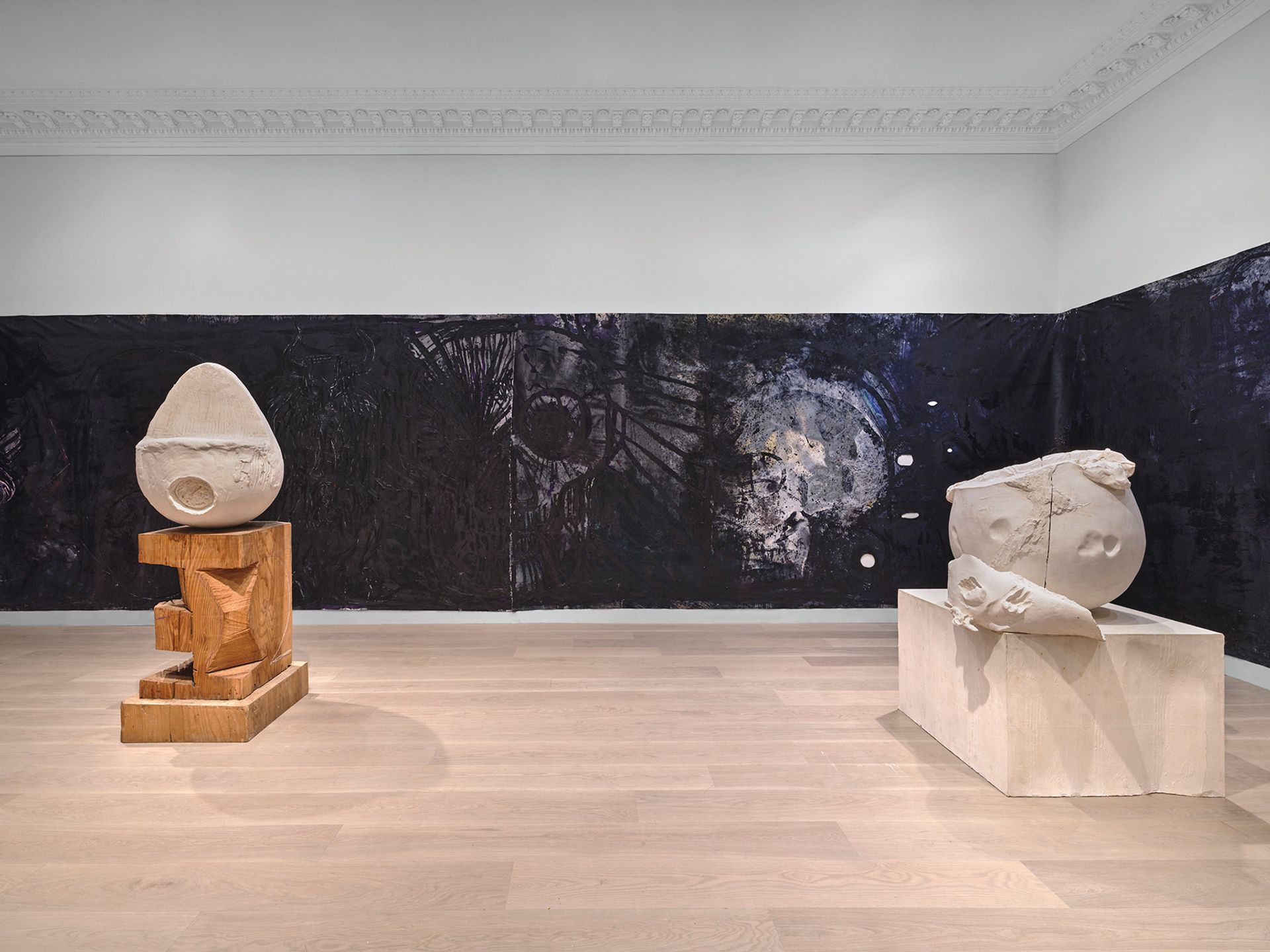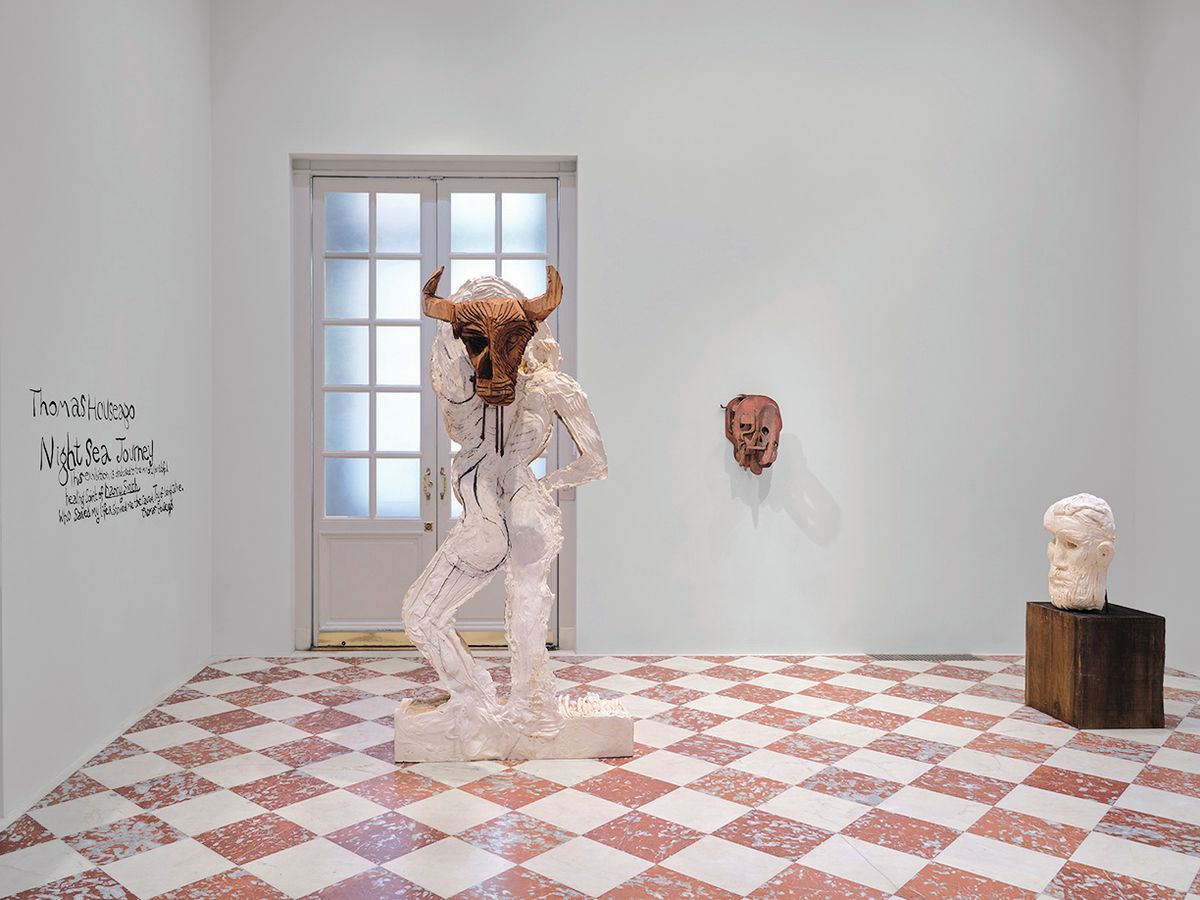One of the bigger jokes of Donald Trump’s seriously unfunny, hopefully single presidency was his repeated promise to build “a beautiful wall” along the southwestern US border and make Mexico pay for it. This boast motivated the artist Thomas Houseago to build his own beautiful wall for the southeastern border of the Los Angeles County Museum of Art’s new campus—and pay for it himself.
“Museums don’t have money for new sculpture,” Houseago claimed, during a preview of his first show in a New York gallery since 2015. “But they’ll accept a gift.” The wall, partly installed now, is a white, deliberately porous façade that will be 162ft long and invite people to enter and exit through eyeball-and teardrop-shaped openings. It has taken nearly ten years to realise, though the British-born Angeleno was not working on it, or any art, all of that time. He couldn’t. Not while he was experiencing complex mental health issues.
Houseago, 52, is no stranger to psychosis. During a talk at the gallery, the artist revealed that in 2019 his siblings told him that he had been sexually abused by a family member as a young child. Unable to comprehend or accept his abuse and betrayal by someone close to him, he turned his rage on himself.
His subsequent treatment was not talk therapy. It was an EDMR (eye movement desensitisation and reprocessing) therapy so torturous that it caused a second period of psychosis. He was helped by Danny Smith, a trauma specialist whom Houseago credits with saving his mental health, and his life. Slowly, he gained the courage to slay his demons by drawing and painting them, finally hoisting a chainsaw to carve them into imposing redwood and plaster totems of his nightmare and healing, a minotaur and an owl.

© Thomas Barratt
These figures, which approach the scale of ancient Egyptian statuary, recur throughout the show at Lévy Gorvy Dayan. In some ways, the story itself is more moving; the roughly hewn works, made out of doors, are an awkward fit in the sanitised grandeur of the mansion. During the walkthrough, Houseago recounted his tale in fits and starts, speaking rapidly, almost shouting, as if to embody the intense energy emanating from his work.
Despite his difficult personal experiences, Houseago has been fortunate in one sense: he has been able to lease affordable land in Malibu, a community better known for the homes of entertainment industry titans than modest artist studios (Leonardo DiCaprio lives next door). Working in the open air was key to the artist’s recovery. He could breathe and move freely, a stark contrast from being locked in a cell for years, screaming. “My dream,” he said, “is to build a sculpture park on cheap land in Malibu.”
Meanwhile, the horrors of his past are visible in the desperately brushed, self-mutilating lines of his paintings and slashed wood and plaster sculptures. “There’s a psychotic quality to sculpture,” he tells the Australian film director Andrew Dominik, in an hour-long video made for the exhibition. “You want the chainsaw to become a brush and dance with you.”
At the preview, Houseago became so consumed by recalling his past that he could speak of little else. The dealer Amalia Dayan encouraged him to say something about his art, but he kept returning to his work with trauma specialist Smith, to whom he dedicated the show and who is namechecked in a few works—particularly a room-swallowing mural so dark it feels like a tunnel to a black hole.
There is respite from the aggressive male energy dominating the show—and, according to Houseago, the politics of the present—in the pleasant environs of a second-floor room where a collection of smaller wood, brass and plaster sculptures of household goods was installed on plinths and a platform. Here, a white, Brancusi-like ovum offers a sense of promise and a wall-bound bronze minotaur head can read as a decorative mask.
The show turns celebratory on the daylight-flooded top floor, where Sunrise, a wraparound landscape painting that more than hints at Edvard Munch, evokes what Houseago characterised as “the reclamation of my soul”.
Mental illness is not a pretty thing to bear or witness, even in the abstract; the one standalone painting, Demon Dream II (2022), is mostly black and very ugly. However, it also holds the most visual interest, with a pair of shoes smothered in paint illustrating the way Houseago was trapped by forces beyond his control. And, though I can’t say I’m a fan of his sculpture, the sensuously grooved back of his largest owl was an exquisite counter to the giant bronze minotaur threatening anyone who dares enter the space.
Houseago had a terrifying experience—one likely to disturb viewers. "Are you broken forever?", he asked himself. The answer was no. "Fuck it," he added, "you keep going until you die."
• Thomas Houseago: Night Sea Journey, Lévy Gorvy Dayan, New York, until 19 October


